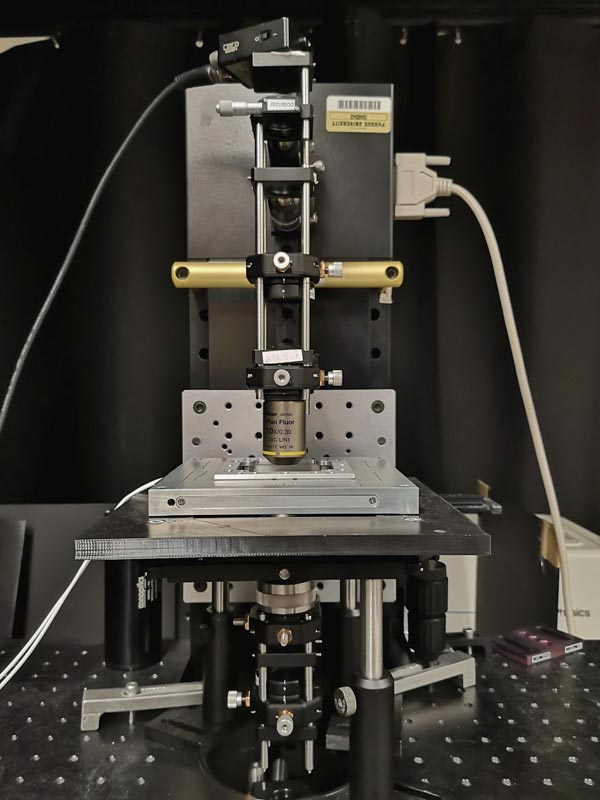Flipping the view: New microscope offers options for drug discovery, safety

A new type of microscope from Purdue University stacks the reference object and the one being examined on top of each other, instead of the conventional approach of having them side by side. Credit: Garth Simpson, Purdue University
A new type of microscope may give doctors a better idea of how safely and effectively a medication will perform in the body.
A Purdue University team developed the microscope based on concepts of phase-contrast microscopy, which involves using optical devices to view molecules, membranes or other nanoscale items that may be too translucent to scatter the light involved with conventional microscopes.
“One of the problems with using the available microscopes or optical devices is that they require a point of reference for the scattered light, since the object being viewed is too optically transparent to scatter the light itself,” said Garth Simpson, a professor of analytical and physical chemistry in Purdue's College of Science, who led the research team.
“We created a unique kind of microscope that stacks the reference object and the one being examined on top of each other with our device, instead of the conventional approach of having them side by side.”
The Purdue microscope uses technology to interfere light from a sample plane and a featureless reference plane, quantitatively recovering the subtle phase shifts induced by the sample. The work is published in the Feb. 18 edition of Optics Express.
The Purdue team created their device by adding just two small optics to the base design of a conventional microscope. The change allows researchers to gather better information and data about the object being viewed.
“The microscope we have created would allow for better testing of drugs,” Simpson said. “You could use our optical device to study how quickly and safely some of the active ingredients in a particular medication dissolve. They may crystallize so slowly that they pass through the body before dissolving, which significantly lowers their effectiveness.”
Simpson said the microscope developed at Purdue could also be used for other types of biological imaging, including the ability to study individual cells and membranes from the body for various medical testing.
Their work aligns with Purdue's Giant Leaps celebration, celebrating the university's global advancements in health as part of Purdue's 150th anniversary. Health research, including advanced biological imaging, is one of the four themes of the yearlong celebration's Ideas Festival, designed to showcase Purdue as an intellectual center solving real-world issues.
Simpson has worked closely with the Purdue Office of Technology Commercialization on a number of patented technologies including this one developed in his lab.
###
About Purdue Office of Technology Commercialization
The Purdue Office of Technology Commercialization operates one of the most comprehensive technology transfer programs among leading research universities in the U.S. Services provided by this office support the economic development initiatives of Purdue University and benefit the university's academic activities. The office is managed by the Purdue Research Foundation, which received the 2016 Innovation and Economic Prosperity Universities Award for Innovation from the Association of Public and Land-grant Universities. For more information about funding and investment opportunities in startups based on a Purdue innovation, contact the Purdue Foundry at foundry@prf.org. For more information on licensing a Purdue innovation, contact the Office of Technology Commercialization at otcip@prf.org. The Purdue Research Foundation is a private, nonprofit foundation created to advance the mission of Purdue University.
Writer: Chris Adam, 765-588-3341, cladam@prf.org
Source: Garth Simpson, gsimpson@purdue.edu
Media Contact
All latest news from the category: Medical Engineering
The development of medical equipment, products and technical procedures is characterized by high research and development costs in a variety of fields related to the study of human medicine.
innovations-report provides informative and stimulating reports and articles on topics ranging from imaging processes, cell and tissue techniques, optical techniques, implants, orthopedic aids, clinical and medical office equipment, dialysis systems and x-ray/radiation monitoring devices to endoscopy, ultrasound, surgical techniques, and dental materials.
Newest articles

Silicon Carbide Innovation Alliance to drive industrial-scale semiconductor work
Known for its ability to withstand extreme environments and high voltages, silicon carbide (SiC) is a semiconducting material made up of silicon and carbon atoms arranged into crystals that is…

New SPECT/CT technique shows impressive biomarker identification
…offers increased access for prostate cancer patients. A novel SPECT/CT acquisition method can accurately detect radiopharmaceutical biodistribution in a convenient manner for prostate cancer patients, opening the door for more…

How 3D printers can give robots a soft touch
Soft skin coverings and touch sensors have emerged as a promising feature for robots that are both safer and more intuitive for human interaction, but they are expensive and difficult…





















